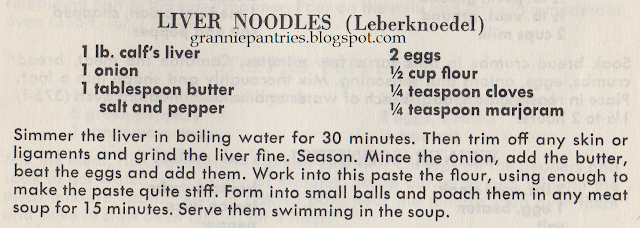I don't mean "hunks" in the "Aren't they so hot?" way. I mean, the illustrations of men in this booklet remind me of hunks of wood. They're just so squat and static looking. The women and girls generally seem more animated, perhaps because they're usually cooking and the artist was better at drawing people who are doing something rather than posing. (And yes, I know the girl with the tureen looks pretty blocky too, but she's posing! That's generally a man's job in this book.)
As for the recipes, this time I was taken in by all the noodles, dumplings, and other usually-carby delights-- perhaps because I'm cold and it's soup weather. As the "usually carby" suggests, they're also not as carb-forward as I expected. Along with more traditional dumplings, the book recommends Egg Balls for Soup.
I'm not sure I ever saw a recipe that called for mixing hard-boiled egg yolks with raw egg yolks before, and these use only "enough flour to hold the [yolk] paste together," so they're more protein-forward than I would have expected.
And while the Liver Noodles are not simply liver cut into noodle-like strips and boiled...
...they are also more egg and liver than flour-- again, just enough flour to bind it all together, making these relatively low-carb for the time. I love that they were to be served "swimming in the soup."
While the book offers a traditional egg noodle recipe...
...it also encourages cooks to fill the noodles, so they're pretty similar to ravioli.
I definitely didn't expect to find ravioli-sh pasta in a Pennsylvania Dutch cookbook.
I did find the carb-on-carb action I expected in the dessert section, though, in a pie that I just don't understand.
Rivels are usually tiny dumplings made by beating flour into a salted egg until it gets crumbly and then boiling the crumbles into a soup. Here, rivels are more like bits of shortbread dough baked onto a pie crust. I'm baffled because why would you want shortbread bits baked onto a pie crust? Wouldn't the whole thing burn after a half-hour at 400°? Or is the "stew" instruction not a misspelling of "strew" as I'm assuming, and there's supposed to be some kind of fruit filling that is entirely missing from the recipe (and the entire page)? Would a couple tablespoons of molasses make a big difference in any of this? I have no idea, so I'm throwing this in as a mystery. In any case, work this mystery over in your head. If you work it enough, you'll earn the right to binge on whatever your favorite foods are, because...
Of course, you may end up looking kind of hunky if it's too hearty...








That is a lot of cooking for beef liver. It sounds like they are using a big hunk of liver instead of the cleaned, thinly sliced beef liver I've cooked with. When cooking liver in butter it's critical to not overcook it. I haven't tried boiling liver, but it's terrible when you overcook it's sauteed.
ReplyDeleteThe liver gets ground, too. Chopped contestants always grind up meat that tends to get tough, so I guess it makes a pretty big difference.
Delete